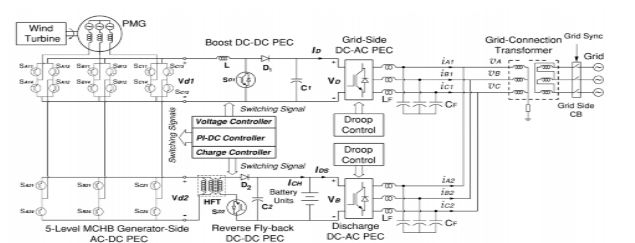Parameter Adjustment for the Droop Control Operating a Discharge PEC in PMG-Based WECSs With Generator-Charged Battery Units
Also Available Domains Hybrid Systems
Objective
Main objective of this project aims to enhance the ability of the PMG-based WECS and its battery storage system to meet their command power delivery, while ensuring the frequency and voltage stability at the PCC.
Abstract
Permanent magnet generator (PMG)-based wind energy conversion systems (WECSs) with battery units, have become a popular class of distributed generation units. These distributed generation units are typically operated using various types of controllers, including droop controllers. Existing droop controllers are designed to operate grid-side dc-ac power electronic converters (PEC) to ensure stable and reliable power production by a PMG-based WECS.
The employment of battery storage units (to mitigate fluctuations in the power produced by a PMG-based WECS) introduces additional considerations for the design of droop controllers. Such considerations are due to the power available from battery units that is dependent on the state-of-charge (SOC). This paper proposes adjustments in the parameters (droop constants) of the droop control (operate the discharge PEC) based on the SOC of the battery units. These adjustments are made to further support stable and reliable power delivery of the PMG-based WECS into the point of-common-coupling (PCC). The proposed adjustments of droop constants are evaluated using a 7.5 kW grid-connected PMG-based WECS with 3.52 kW generator-charged battery storage units.
Keywords: Permanent magnet generators, wind energy conversion systems, battery storage systems, droop control, distributed generation.
NOTE: Without the concern of our team, please don't submit to the college. This Abstract varies based on student requirements.
Block Diagram

Specifications
Software Configuration:
Operating System : Windows 7/8/10
Application Software : Matlab/Simulink
Hardware Configuration:
RAM : 8 GB
Processor : I3 / I5(Mostly prefer)
Learning Outcomes
- Introduction to Matlab/Simulink
- What is EISPACK & LINPACK
- How to start with MATLAB
- About Matlab language
- About tools & libraries
- Application of Matlab/Simulink
- About Matlab desktop
- Features of Matlab/Simulink
- Basics on Matlab/Simulink
- How to Improve Power Quality?
- Introduction to Renewable energy sources.
- Introduction to Matlab/Simulink software
- Introduction to FACTS devices
- Design of solar PV system.
- Introduction to power converters.
- Design of Voltage source converter.
- Design of Boost converter.
- Design of MPPT controller.
- Design of UPQC.
- Design of BESS.
- How BESS works?
- Design of sim power systems tool boxes.
- Design of simulink tool boxes.
- We can learn about the generation of gate pulses to the converter.
- We can learn about the differences between Linear and nonlinear loads.
- Introduction to controllers.
- Design of PI controller.
- Introduction to open loop and closed loop control system.
- We can learn about the Clarke’s transformation.
- We can learn about the park’s transformation.
- Design of PLL.
- Introduction to PWM.
- Design of Hysteresis controller.
- Design of self-tuning filter (STF) integrated with the unit vector generator (UVG) technique.
- Project Development Skills:
- Problem analyzing skills
- Problem solving skills
- Creativity and imaginary skills
- Programming skills
- Deployment
- Testing skills
- Debugging skills
- Project presentation skills





 Paper Publishing
Paper Publishing
